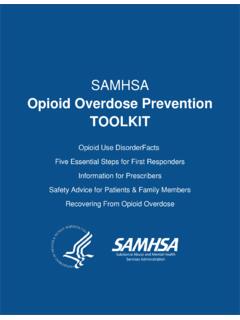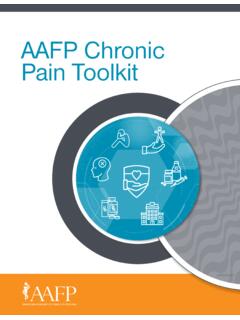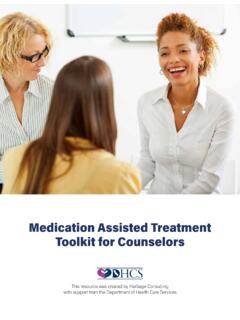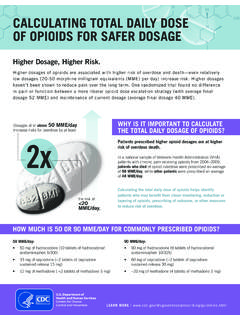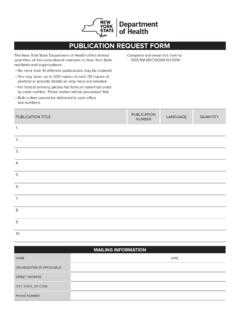Transcription of Overdose Fatality Review Practitioners Guide
1 Overdose Fatality Review A Practitioner s Guide to Implementation Acknowledgment This document was authored by Melissa Heinen and Mallory O Brien, Institute for Intergovernmental Research. Financial support for this toolkit was provided by the Bureau of Justice Assistance, Office of Justice Programs, Department of Justice and the Centers for Disease Control and Prevention. Released: July 2020 Learn more about the Overdose Fatality Review at About BJA The Bureau of Justice Assistance (BJA) provides leadership and services in grant administration and criminal justice policy development to support local, state, and tribal law enforcement in achieving safer communities.
2 To learn more about BJA, visit and follow us on Facebook ( ) and Twitter BJA is part of the Department of Justice s Office of Justice Programs. This project is supported by the Bureau of Justice Assistance (BJA), Office of Justice Programs, Department of Justice, and the Centers for Disease Control and Prevention by Grant No. 2017-AR-BX-K003 awarded by BJA. The contents of this document were developed by the Institute for Intergovernmental Research and do not represent the official position or policies of the Department of Justice or the Centers for Disease Control and Prevention.
3 Table of Contents What Is the Overdose Epidemic?..2 Are Overdose Deaths Preventable?..2 What Is an Overdose Fatality Review (OFR)?..2 Why Are OFRs a Useful Strategy for Preventing Overdose toolkit Module 1. Recruit Your OFR 1A. OFR 1B. OFR Leadership Roles and 1C. OFR Team Facilitation 1D. OFR Team Coordination 1E. OFR Data Manager 1F. OFR 1G. Governing 1H. OFR Overall Module 2. Plan Your OFR Meeting ..13 2A. Meeting 2B. Meeting Preparation: Coordinator s 2C. Meeting Preparation: Members Module 3.
4 Facilitate Your OFR 3A. Facilitator s 3B. Guiding 3C. Meeting 3D. Meeting Facilitation 3E. Managing Difficult 3F. Measuring Meeting 3G. Meeting 3H. Post-Meeting 3I. Updating the Governing 3J. Preventing Case Review Overdose Fatality Review : A Practitioner s Guide to Implementation / iii Module 4. Collect Your OFR 4A. 4B. Data Collection 4C. OFR Module 5. Build a Recommendation 5A. Identifying Recommendations During the OFR 5B. Documenting 5C. Forming a Subcommittee to Develop 5D.
5 Subcommittee Roles and 5E. Implementing a 5F. Assessing and Monitoring Appendix A: Resources for Model 1. Recruit Your OFR Sample: OFR Recruiting Sample List: Facilitator Sample Checklist: OFR Appendix B: Resources for Model 2. Plan Your OFR Meeting ..43 Coordinator s Meeting Preparation Sample: OFR Sample: OFR Case Sample: Member s Guide to Collecting Case Sample: Agency-Specific Data Sample: OFR Two-Week Reminder Sample: Case Summary Sample: Summary Data Sample: Meeting Ground Appendix C: Resources for Model 3.
6 Facilitate Your OFR Sample Template: Meeting Sample: Governing Committee Report Appendix D: Resources for Model 4. Collect Your OFR Sample: Interagency Data Sharing Sample: Confidentiality Sample: Confidentiality Agreement and Review Sign-In Template: OFR Data Sharing Appendix E: Resources for Model 5. Build a Recommendation Plan ..61 Sample: Recommendation Work iv / Overdose Fatality Review : A Practitioner s Guide to Implementation Overview What Is the Overdose Epidemic? Drug overdoses are a leading cause of death in the United States.
7 From 1999 to 2017, more than 702,000 people died from a drug Overdose in America; 67,000 died in 2018. Pointing to progress in addressing the epidemic, there were 4 percent fewer Overdose deaths in 2018 compared with 2017. Are Overdose Deaths Preventable? Yes. Overdose deaths can be prevented with coordinated prevention strategies, timely implementation of evidence- based interventions, community mobilization, and supportive families and friends. The shared understanding that Overdose deaths are preventable guides the entire Overdose Fatality Review (OFR) process.
8 Federal agencies, such as the Bureau of Justice Assistance (BJA) and the Centers for Disease Control and Prevention (CDC), are strategically coordinating to mobilize local communities to develop and implement OFRs. What Is an Overdose Fatality Review (OFR)? The purpose of an OFR is to effectively identify system gaps and innovative community-specific Overdose prevention and intervention strategies. In practice, OFRs involve a series of confidential individual death reviews by a multidisciplinary team. A death Review Overview (also referred to as a case Review ) examines a decedent s life cycle in terms of drug use history, comorbidity, major health events, social-emotional trauma (including adverse childhood experiences), encounters with law enforcement and the criminal justice system, treatment history, and other factors, including local conditions, to facilitate a deeper understanding of the missed opportunities for prevention and intervention that may have prevented an Overdose death.
9 By conducting a series of OFRs, jurisdictions begin to see patterns of need and opportunity, not only within specific agencies but across systems. Blending input from public health, public safety, providers, and the community, OFR teams develop program and policy recommendations to improve coordination and collaboration between agencies and community conditions to prevent future Overdose deaths. These recommendations are presented to a governing committee that supports and provides resources for implementation and a framework for accountability for action.
10 Examples of successful recommendations include the integration of peer recovery specialists into new settings, targeted naloxone distribution, and improved coordination of public safety and public health. Why Are OFRs a Useful Strategy for Preventing Overdose Deaths? Fatality reviews are used to address several complex public health issues. Reviews such as homicide, child death, maternal mortality, critical incidents, suicide, and 2 / Overdose Fatality Review : A Practitioner s Guide to Implementation Overdose deaths share many common components such as a focus on prevention, convening of multidisciplinary teams to do a series of case reviews, identification of missed opportunities for prevention and intervention, and development and implementation of data-driven prevention and intervention strategies.
